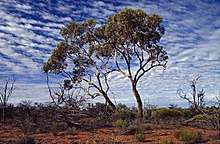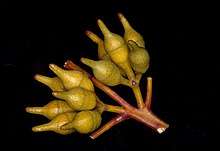Eucalyptus socialis subsp. victoriensis
Eucalyptus socialis subsp. victoriensis, commonly known as the red mallee,[2] is a subspecies of mallee that is endemic to southern inland Australia. It usually has rough bark on the base of the trunk, smooth bark above, lance-shaped adult leaves, flower buds in groups of between seven and eleven, pale creamy yellow flowers and barrel-shaped to urn-shaped or spherical fruit.
| Red mallee | |
|---|---|
 | |
| Subspecies victoriensis near Cook in the Great Victoria Desert | |
| Scientific classification | |
| Kingdom: | Plantae |
| Clade: | Tracheophytes |
| Clade: | Angiosperms |
| Clade: | Eudicots |
| Clade: | Rosids |
| Order: | Myrtales |
| Family: | Myrtaceae |
| Genus: | Eucalyptus |
| Species: | |
| Subspecies: | E. s. subsp. victoriensis |
| Trinomial name | |
| Eucalyptus socialis subsp. victoriensis | |

Description
Eucalyptus socialis subsp. victoriensis is a mallee that typically grows to a height of 3–8 m (9.8–26.2 ft) and forms a lignotuber. It usually has rough, loose, fibrous or flaky bark at the base of the trunk, smooth tan to grey bark above. Adult leaves are the same shade of dull bluish green on both sides, lance-shaped, 80–152 mm (3.1–6.0 in) long and 20–35 mm (0.79–1.38 in) wide and petiolate. The flower buds are arranged in leaf axils usually in groups of between seven and eleven, on an unbranched peduncle 4–18 mm (0.16–0.71 in) long, the individual buds on pedicels 2–8 mm (0.079–0.315 in) long. Mature buds are 12.5–19 mm (0.49–0.75 in) long and 4–6.5 mm (0.16–0.26 in) wide with a horn-shaped operculum that is longer than the floral cup. The flowers are pale creamy yellow and the fruit is a woody barrel-shaped to urn-shaped or spherical capsule 7–11 mm (0.28–0.43 in) long and 6.5–9.5 mm (0.26–0.37 in) wide.[2][3][4]
Taxonomy and naming
Eucalyptus socialis subsp. victoriensis was first formally described in 2005, by Dean Nicolle in Australian Systematic Botany from specimens collected near Neale Junction in 1999, close to the border between South Australia and Western Australia.[5] The epithet victoriensis refers to this species' distribution in the Great Victoria Desert.[2]
Distribution and habitat
This red mallee grows in mallee on sandplains and between sand dunes, often with other eucalypts, including E. concinna, E. eremicola and E. pimpiniana. It is restricted to the Great Victoria Desert in South Australia and Western Australia.[2]
Conservation status
This mallee subspecies is classified as "not threatened" by the Western Australian Government Department of Parks and Wildlife.[3]
References
- "Eucalyptus socialis subsp. victoriensis". Australian Plant Census. Retrieved 28 December 2019.
- Nicolle, Dean (2013). Native Eucalypts of South Australia. Adelaide: Dean Nicolle. pp. 72–73. ISBN 9780646904108.
- "Eucalyptus socialis subsp. victoriensis". FloraBase. Western Australian Government Department of Parks and Wildlife.
- "Eucalyptus socialis subsp. victoriensis". Euclid: Centre for Australian National Biodiversity Research. Retrieved 29 May 2020.
- "Eucalyptus socialis subsp. victoriensis". APNI. Retrieved 28 December 2019.